Cucumbers have hundreds of varieties, and growing only one type does not feel enough. You must be wondering whether you can grow multiple varieties together. That’s what we will talk about here.
You can grow different cucumber varieties together. You need to consider a few things, for example, spacing, pollination management, and choosing the ideal variety. Though planting different varieties provides benefits, some gardeners don’t recommend it because of cross-pollination.
In this article, we will learn about the different cucumber varieties, the benefits of growing them together, the factors to consider before growing them, and how to save seeds in such a growth system.
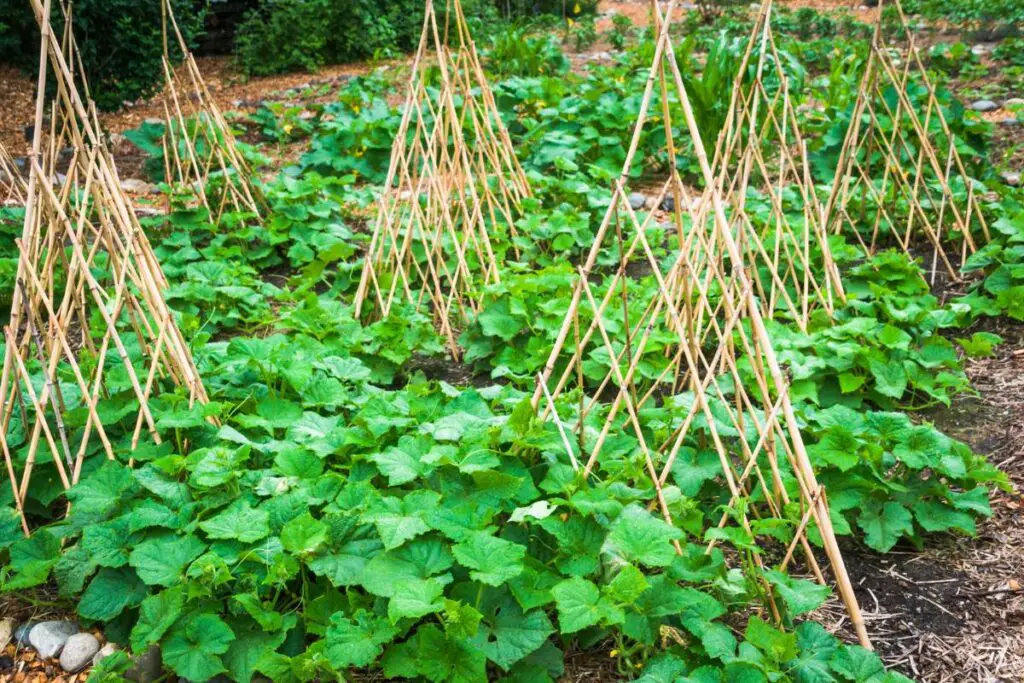
Understanding the cucumber varieties
There are several varieties of cucumbers. But they are divided based on the following:
- Culinary and usage features
- Growth habits
- Reproductive characteristics
Culinary and usage features
Based on the culinary and usage characteristics, cucumbers are divided into three categories:
- Slicing
- Pickling
- Seedless or burpless
But, some seedless categories go into the slicing category, and some go to the pickling variety, so cucumbers are now classified into slicing and pickling.
The slicing varieties are used in salads, garnish food and drinks, and even eaten raw. These cucumbers are large, measuring 6 to 9 inches.
Some slicing cucumber varieties include:
- Diva
- Sweet success
- Slice master
- Marketmore 76
- Bush Champion
- Chinese snake
- Tendergreen
- Ashley
On the contrary, the pickling varieties are used to make cucumber pickles. Since they are used for pickles, they measure only 2 to 4 inches.
Some pickling varieties include:
- Gherkins
- Kirby
- Burpee pickler
- Fresh pickles
- Homemade pickles
- Picklebush
- National pickling
- Northern pickling
Growth habit
Based on their growth habit, the cucumbers are classified into two categories:
- Bush varieties
- Vining varieties
The vining varieties are the default cucumber varieties.
These can take up a lot of space in your garden; thus, experts recommend growing them on a trellis.
The cucumbers come out small, but you cannot control them once they grow.
The vines can grow around 6 to 7 feet long.
Some ideal vine varieties are:
- Diva (5-6 feet)
- Mexican sour Gherkin (3-4 feet)
- Baby cucumbers (6 feet and 6 inches)
On the other hand, the bush varieties do not have such crawling habits.
They have vines, but their length is short, around only 2 to 3 feet.
Two common bush varieties are:
- Pick a Bushel (10-12 inches)
- Saladmore Bush Hybrid (8-10 inches).
Reproductive characteristics
Based on this group, the cucumbers are divided into 3 categories:
- Monoecious
- Gynoecious
- Parthenocarpic
Monoecious cucumbers grow both male and female flowers in the same plant.
So, they can self-pollinate naturally through wind and pollinators. Some examples of monoecious variety are:
- Homemade Pickles
- Muncher
- Spacemaster 80 Bush
- Itachi
- Lemon
- Marketmore 76
- Striped Armenian
The gynoecious cucumbers grow only female flowers and a few or no male flowers.
So, these will need some monoecious plants from cross-pollination to grow more fruits.
Some gynoecious varieties are:
- Bristol
- Citadel
- Olympian
- Gherkin hybrid
- Mini Much
- Sweet success
The parthenocarpic plants do not need any pollination. They don’t have seeds and can grow new fruits without any pollination.
Some examples of Parthenocarpic cucumbers are:
- County Fair Improved Hybrid
- Goliath Hybrid
- Diva Hybrid
- Nokya
- Tasty Jade
- Picolino
- Socrates
Benefits of growing different cucumber varieties together
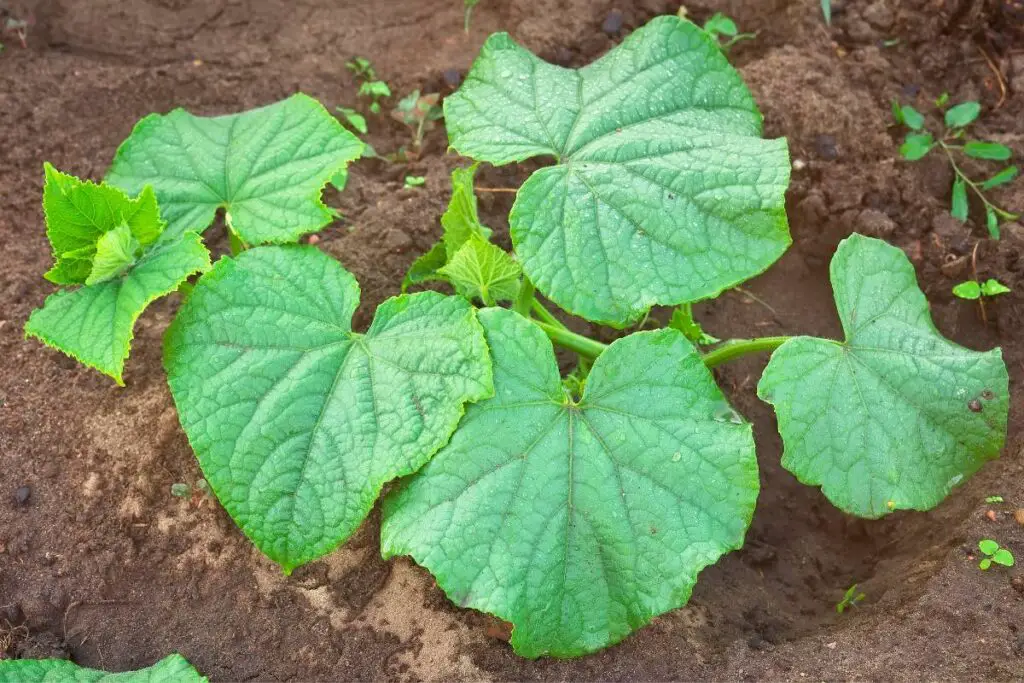
Cucumbers have hundreds of varieties, and you can grow anyone you want. All of them are easy to grow and maintain.
With proper care and maintenance, you can have juicy and plumpy cucumbers.
But you will benefit more if you grow them together in your garden.
Here are some benefits you will receive:
Constant supply of the cucumbers
You can receive multiple types of cucumbers and use them as you want.
Each variety will have a different maturity date.
For example, suppose you grow an early-maturing cucumber variety and one late-maturing variety.
In that case, you will have cucumbers throughout the year.
Looking for gardening supplies? We have tested 100's of products before recommending them to you guys. Check out our best pick below:
| Image | Gardening Supplies | Best Price? |
|---|---|---|
 Top
Top Top
Top | Raised Garden Bed Kit | Check On Amazon |
 | XLUX Soil Moisture Meter, Plant Water Monitor, Soil Hygrometer Sensor for Gardening, Farming, Indoor and Outdoor Plants, No Batteries Required | No Results |
 Top
Top Top
Top | 82 Pcs Garden Tools Set and Extra Succulent Tools Set | Check On Amazon |
 | Joeys Garden Expandable Garden Hose with 8 Function Hose Nozzle, Lightweight Anti-Kink Flexible Garden Hoses, Extra Strength Fabric with Double Latex Core, (50 FT, Black) | No Results |
 Top
Top Top
Top | Dual Chamber Compost Tumbler | Check On Amazon |
 Top
Top Top
Top | Sunnyglade Plant Stakes | Check On Amazon |
 Top
Top Top
Top | Organic Cold Pressed Neem Seed Oil | Check On Amazon |
 Top
Top Top
Top | Mighty Mint Gallon :-Insect and Pest Control Peppermint Oil | Check On Amazon |
 Top
Top Top
Top | Scotts DiseaseEx Lawn Fungicide | Check On Amazon |
 Top
Top Top
Top | Jacks Classic 20-20-20 All Purpose Fertilizer | Check On Amazon |
 Top
Top Top
Top | 30,000 Seeds Pollinator Attracting Wildflower Mixture | Check On Amazon |
 Top
Top Top
Top | Survival Vegetable Seeds Garden Kit-Over 16,000 Seeds | Check On Amazon |
Disease resistance
Growing different cucumber varieties can prevent diseases.
Each variety contains immunity strength to fight against various diseases.
When you grow them together, all of them will protect each other and fight against diseases.
Moreover, when two varieties cross-pollinate while growing close, and a hybrid is produced, it will collect the best traits from its parents.
As a result, the plant can become tough and increase disease resistance.
Improves flavor
Growing cucumbers together can improve the flavor of the cucumber fruits.
Each variety contains a unique flavor.
When you grow different varieties together, the different cucumber flavors combine and make a delicious smell in the cucumbers.
Cross-pollination: A significant challenge to face
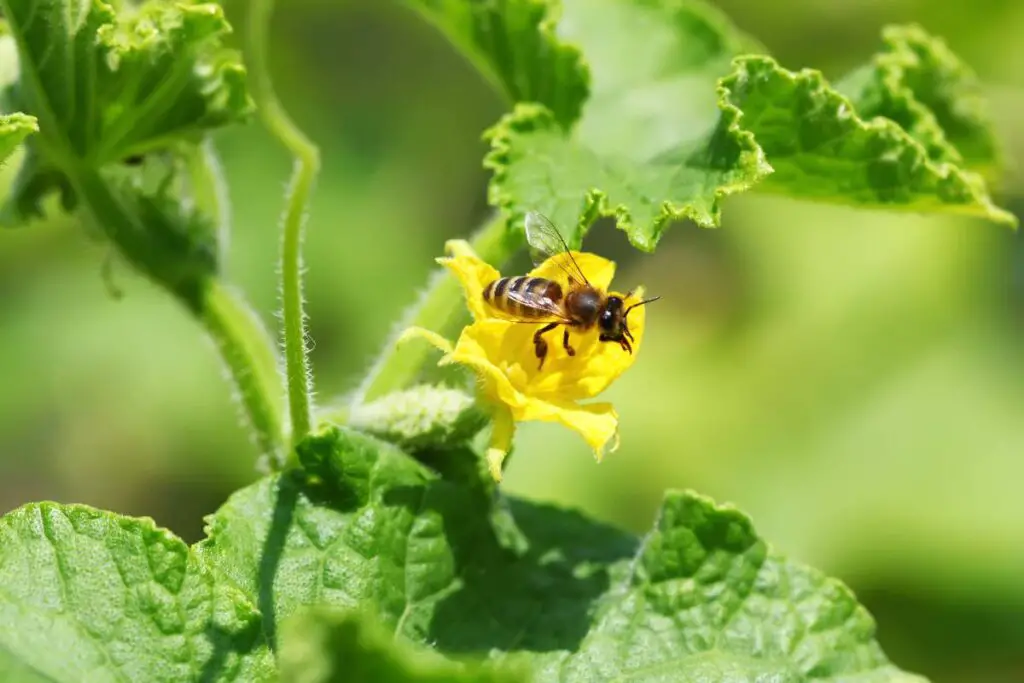
Growing the different varieties of cucumbers together in the garden should be fine.
It is known to provide you with numerous benefits, as explained in the previous section.
But, a challenge you might face while growing them together is cross-pollination.
All the varieties do not cross-pollinate successfully.
Cross-pollination is not encouraged by most cucumber plant owners because you lose the genetic purity of the cucumbers.
Some people grow specific cucumber varieties because of their features, like being disease-resistant, making pickles, eating raw, or adding them to salads.
When you have gynoecious varieties, then you need to encourage cross-pollination.
For a successful cross-pollination, the pollen of one variety needs to fertilize the ovules of the other variety.
If both varieties are incompatible, there won’t be any cross-pollination.
The cucumbers with monoecious features will have both males and females on the same plant.
The male flowers can produce pollen, and the female ones will produce ovules to get fertilized by the pollen and become cucumber fruits.
When two varieties are compatible and can cross-pollinate, they won’t produce offspring identical to their parents.
It will have different traits and be a hybrid of two parents.
There are a few drawbacks of cross-pollination:
Taste and flavor
When the cucumbers cross-pollinate, the taste and flavor of the cucumbers change.
It becomes bitter and weird. Even if you can eat it, you won’t be able to enjoy it.
Lost genetic purity
Suppose you are growing both pickle and slicing variety together.
Still, you want to use it for which it is intended.
But, if cross-pollination occurs between the two, you can neither make pickles with the hybrid nor add it to the salad.
As a result, the cucumber loses its intended use and genetic purity.
Things to consider while growing different cucumber varieties together
You can grow different cucumber varieties together.
But there are a few factors you need to consider before that.
For example, you must consider the spacing for their uncontrollable vines, manage the pollination, and care for them to prevent resource competition.
This section discusses those factors:
Plant spacing
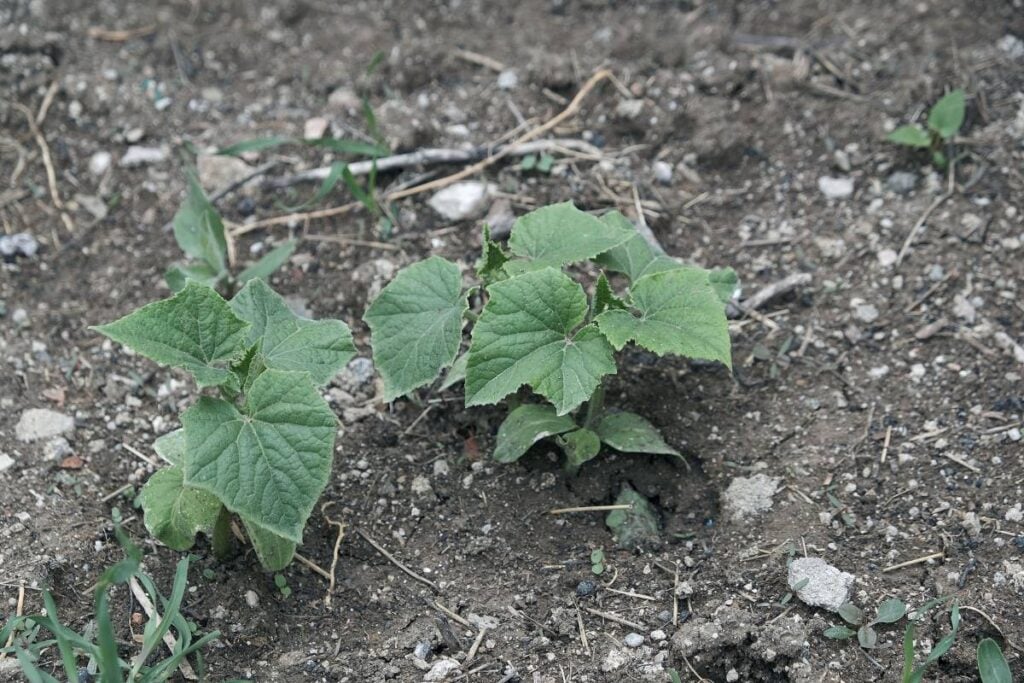
It is one of the most essential factors to consider.
Cucumbers have a crawling growth habit.
If given space, they will cover up the whole garden.
The vining cucumber varieties grow longer than the bush varieties.
The bush varieties will require less space as they grow only 2-4 feet long.
As for the vining varieties, you must prepare enough space for them.
If growing the cucumbers in a trellis, maintain at least 1 foot of distance between them.
If you allow the cucumbers to sprawl on the ground, maintain at least 3 feet of distance between each plant.
For the dwarf bush varieties, plant them 1-2 feet apart.
Another important reason for maintaining proper spacing is their requirements.
All the cucumbers have the exact requirements:
- 6 to 8 hours of sunlight
- Regular watering
- Well-drained nutritious soil
- Weekly fertilization
So, they may fight for sunlight, moisture, and nutrients.
So, it is better to provide enough space and requirements for all the varieties and prevent them from competing.
Pollination management
There are two ways to manage pollination:
- Prevent cross-pollination
- Allow cross-pollination
Prevent cross-pollination
If you don’t want your cucumbers to cross-pollinate, you must control it by hand-pollinating and preventing pollinators.
To stop the pollinators from reaching your cucumbers, grow the varieties at least 1,500 meters away and create barriers around the plant.
For hand-pollination, identify the male and female flowers.
The male flowers bloom first, and the female blooms after 2-3 weeks.
The male flowers will bloom in clusters of 3-5 with shorter stems.
The female flowers grow by themselves, and only one bloom per stem.
They have the ovary at the center.
Take the pollen from the male flowers with a cotton swab or paintbrush and rub it in the female flowers.
Be gentle, as the pollen is small and sticky.
Allow cross-pollination
Though many gardeners avoid cross-pollination to maintain the genetic purity of the cucumbers, there are situations where you need this.
For example, gynoecious cucumbers must cross-pollinate with the monoecious varieties to produce fruits.
Gynoecious have only female flowers.
They will cross-pollinate with the female flowers of the monoecious varieties to produce fruits.
When you buy gynoecious seeds, some monoecious seeds come packed along for pollination.
Yield and harvest
While growing different cucumbers, you need to consider the harvest timing of the cucumbers you are growing.
Each variety has a different harvest time. You can choose anyone according to it.
Please pay attention to the harvest time of all the varieties and collect them when the time comes. Regular harvests will lead to more yields.
If you want to receive all the cucumber varieties at only one time, grow those varieties that take almost the same time to get ready for harvest.
But for a year-round cucumber harvest, grow both early and late-maturity cucumbers.
To avoid cross-pollination, plant cucumbers that have different harvest times.
Or plant them at different times so the flowering times stay different.
Disease resistance
Different cucumber varieties can resist different types of diseases.
So, when you grow multiple varieties together, grow disease-resistant varieties.
The varieties will protect each other and minimize the risk of diseases.
Also, keep your garden clean to prevent infections.
Moreover, when some hybrid cucumbers get produced, they get the best traits of their parents.
These cucumbers can have an increased resistance to diseases.
Use trellis
We all know that cucumbers have crawling habits.
Once the vines start spreading, stopping them from spreading over the ground is impossible.
To prevent this, consider vertical gardening with a trellis, which takes up less space in your garden.
Use separate trellis for each variety to give them enough space for uninterrupted growth.
And with different styles of trellises, your garden will become the center of attraction.
Other factors
Besides these, there are other factors to consider, for example:
- Cucumbers are from the Cucurbit family. Watermelons, cantaloupes, pumpkins, and squashes belong to the same family. Though the seeds won’t be compatible, it is better to keep them away from each other and prevent cross-pollination.
- All the varieties will need full sunlight for 6 to 8 hours, regular watering, well-drained soil, and proper fertilization every week. Make sure to maintain this for all the varieties. Since they will grow together, provide enough requirements to prevent them from competing.
Seed saving
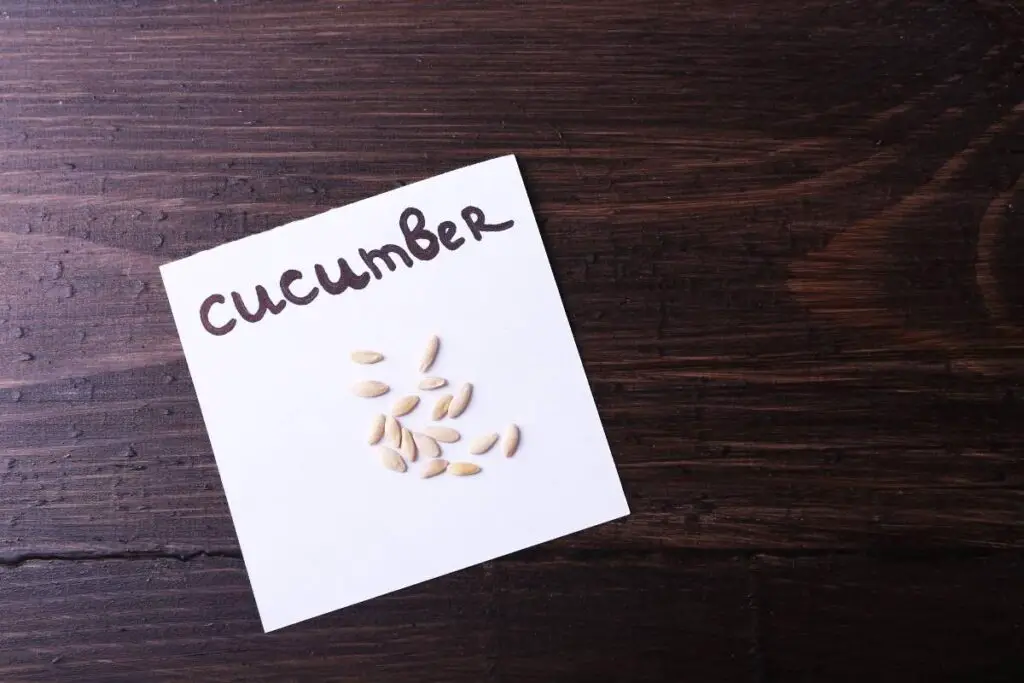
To save the seeds of the true cucumber varieties, growing them together can be a problem because of cross-pollination.
You need to prevent cross-pollination at all costs.
To save the seeds manually, hand-pollinate and encourage the growth of mature cucumbers.
Bring some red twine and a paintbrush.
The red twine will stand out to hold the color later in the season.
Identify the male and female flowers.
When the buds open, tie a small red twine behind the immature cucumber as a mark.
Once the flower opens, brush the paintbrush against the male flower’s pollen and apply it directly to the female flower’s stigma.
Close the flower over to prevent bees from roaming around it and pollinating.
Within a few hours, the pollen will get carried to the ovules.
The day before the flowers open, the yellow petals will slowly unfurl within a few days.
When the fruit has fully developed, it is time to save the seeds:
- Cut open the mature cucumbers, scoop the seeds with a spoon, and rinse them under running water.
- Spread the seeds over a plate or tray and let them dry for 3 days. Keep them out of direct sunlight.
- Once dried, store them in an airtight container. Please keep them in a cool, dark place until the next planting season or until the spring planting time arrives.
Companion planting
Companion planting included two things:
- Companion planting within cucumber varieties.
- Companion planting with other plants
Cucumber varieties together
There are no specific varieties to grow together.
Since all are cucumbers, you can grow together any 2-3 varieties according to your choice.
- I recommend growing Lemon and Bitter Gourd together as the best varieties to grow as companions. Both are well-suited for growing in warmer climates and high yields. You can also help them pollinate for better crop production.
- Grow monoecious companions with the gynoecious. Try growing Diva with Marketmore or Straight Eight. One is gynoecious, and the other is monoecious. When cross-pollinated, the Diva will be able to produce fruits.
- Another option is to grow Dill and a pickler variety. These have different strengths and traits and will complement each other. Dill is a great cucumber variety for making pickles. So, growing it with a pickler variety will make the cucumbers flavorful.
Other cucumbers to grow together as companions are:
- English or Burpless cucumbers
- Armenian cucumbers
- Pickling cucumbers
- Asian cucumbers
While growing these varieties together, consider the factors I have shared previously.
Companion planting with other plants
There are many companions to grow with cucumbers.
Companion planting will give your garden a unique look, attract pollinators, and benefit each other.
Some companions to plant with cucumbers are:
- Dill and oregano
- Garlic and onions
- Pole and bush beans
- Peas
- Radishes, beets, and carrots
- Marigolds, nasturtiums, and sunflowers
Final thoughts
Growing different cucumber varieties together is fine, but cross-pollination is your main challenge. Where most gardeners do not want to grow the cucumbers together for this, some gardeners benefit in yields by this. By growing different varieties together, you receive more yields throughout the year.
The cucumber’s flavor improves when the flavors of different varieties get mixed, and you receive cucumber year-round because different varieties have different harvest times. As for cross-pollination, you can prevent it by keeping cucumbers away from each other, creating physical barriers, and encouraging hand-pollination among the same variety.
However, gynoecious cucumbers will need cross-pollination. So, whether to encourage cross-pollination depends on which variety you are growing. While growing different varieties, consider all the mentioned factors. It will encourage high yields and tasty and plumpy cucumbers without any issues.
Do I need more than one cucumber?
You will need more than one cucumber variety if your current variety is a gynoecious plant. Since they do not grow any male flowers, you need some monoecious varieties as they grow both male and female flowers.
Is there any other way to pollinate the gynoecious cucumbers except cross-pollination?
Try using blossom set spray, which provides kinetin and influences the flowers to produce food without pollination.
Reference: Cucumber varieties Wikipedia
